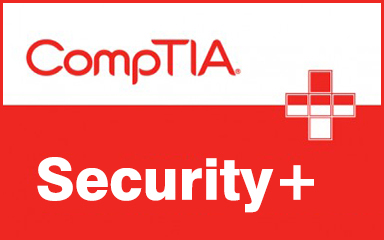Security+课程

Security+ 认证是一种中立第三方认证,其发证机构为美国计算机行业协会 CompTIA ;是和 CISSP、 CISA 等共同包含在内的国际 IT 业 10 大热门认证之一,和 CISSP 偏重信息安全管理相比,Security+ 认证更偏重信息安全技术和操作, Security+ 认证考试包括选择题和实践题(要求您在模拟环境下进行 实践)。通过该认证证明了您具备网络安全,合规性和操作安全,威胁和漏洞,应用程序、数据和主机安 全,访问控制和身份管理以及加密技术等方面的能力。因其考试难度不易,含金量较高,目前已被全球企 业和安全专业人士所普遍采纳。

开课形式:周末班、晚班。
就业方向:安全架构师、安全工程师、安全顾问、安全或系统管理员、信息保证技术员。
认证好处:
好处 1:在增长较快的一个 IT 领域发展您的技能并成为您的雇主的宝贵人才,晋升机会大。
好处 2:由于安全威胁越来越大,您进入的领域,是一个任何 IT 行业内安全专业人员和合格 IT 人员需 求量最大的领域,行业前景好。
好处 3:凭借经过 Security+ 认证的知识和技能享受丰厚回报。一些安全专业人员、架构师和工程师的 年薪超过 86,000 美元,薪资水平高。
好处 4:美国国防部高度重视 Security + 认证,因此将其纳 8570.01-M 指令。中国各大企业也逐渐开 始高度重视 Security + 认证,并逐渐开始培养 Security + 人才,持有 Security + 证书人才的职业发 展前景无限好。
好处 5: Security+ 是全球认可的认证证书,获得 Security+ 认证的专业人员遍布全球 147 个国家/地 区,助您成为国际信息安全专业人才。

| 培训章节 | 培训内容 |
|---|---|
| 一 NETWORK SECURITY 网络安全 | |
| Implement security configuration parameters on network devices and other technologies. 在网络设备和其他设备上实施安全配置参数 | Firewalls 防火墙 Routers 路由器 Switches 交换机 Load Balancers 负载均衡 Proxies 代理 Web security gateways Web 安全网关 VPN concentrators VPN 网关 NIDS and NIPS 网络入侵检测与网络入侵防范 Protocol analyzers 协议分析仪 Spam filter 垃圾邮件过滤 UTM security appliances 统一威胁管理 Web application firewall vs. network firewallWeb 应用防火墙与网络防火墙 Application aware devices 应用端设备 |
| Given a scenario, use secure network administration principles. 给定一个场景,应用安全网络管理原则 | Rule-based management 基于规则的管理 Firewall rules 防火墙规则 VLAN management VLAN 管理 Secure router configuration 安全路由配置 Access control lists 访问控制列表 Port Security 端口安全 802.1x 802.1x Flood guards 流量攻击防护 Loop protection 环路保护 Implicit deny 默认拒绝 Network separation 网络隔离 Log analysis 日志分析 Unified Threat Management 统一威胁管理 |
| Explain network design elements and components. 解释网络设计的元素和组件 | DMZ 非军事化区 DMZ Subnetting 子网 VLAN 虚拟局域网 NAT 网络地址翻译 Remote Access 远程接入 Telephony 电话 NAC 网络接入控制 NAC Virtualization 虚拟化 Cloud Computing 云计算 Layered security / Defense in depth 分层安全 / 深度防御 |
| Given a scenario, implement common protocols and services. 给定一个场景,实施通用的协议和服务 | Protocols 协议 Ports 端口 OSI relevance OSI相关 |
| Given a scenario, troubleshoot security issues related to wireless networking. 给定一个场景,对无线组网中的安全问题进行故障排查 | WPA WPA2 WEP EAP PEAP LEAP MAC filter MAC 过滤 Disable SSID broadcast 禁用 SSID 广播 TKIP CCMP Antenna Placement Power level controls Captive portals Antenna types Site surveys VPN (over open wireless) |
| 二. COMPLIANCE AND OPERATIONAL SECURITY合规与运维安全 | |
| Explain the importance of risk related concepts. 解释风险相关概念的重要性 | Control types 控制类型 False positives 误报 False negatives 漏报 Importance of policies in reducing risk 风险降低策略的重要性 Risk calculation 风险计算 Quantitative vs. qualitative 定量 vs. 定性 Vulnerabilities 漏洞 Threat vectors 威胁 Probability / threat likelihood可能性/威胁可能性 Risk-avoidance, transference, acceptance, mitigation, deterrence 风险规避,转移,接受,降低,威慑 Risks associated with Cloud Computing and Virtualization云计算与虚拟化相关的风险 Recovery time objective and recovery point objective恢复时间目标与恢复点目标 |
| Summarize the security implications of integrating systems and data with third parties. 总结与第三方集成系统与数据的安全含义 | On-boarding/off-boarding business partners 驻场 / 场外的业务合作伙伴 Social media networks and/or applications 社交媒体网络与应用 Interoperability agreements 互操作协议 Privacy considerations 隐私考虑 Risk awareness 风险意识 Unauthorized data sharing 非授权数据共享 Data ownership 数据所有权 Data backups 数据备份 Follow security policy and procedures 遵从安全策略与程序 Review agreement requirements to verify compliance and performance 审核协议需求来确认合规性与性能 standards 标准 |
| Given a scenario, implement appropriate risk mitigation strategies. 给定一个场景,实施正确的风险降低策略 | Change management 变更管理 Incident management 事件管理 User rights and permissions reviews 用户权限审核 Perform routine audits 执行日常审计 Enforce policies and procedures to prevent data loss or theft 加强策略和程序来阻止数据的损失或失窃 Enforce technology controls 加强技术控制 |
| Given a scenario, implement basic forensic procedures. 给定一个场景,实施基本的取证程序 | Order of volatility 波动的顺序 Capture system image 获取系统镜像 Network traffic and logs 网络流量与日志 Capture video 获取视频录像 Record time offset 记录时间偏离 Take hashes 进行哈希校验 Screenshots 截屏 Witnesses 目击者 Track man hours and expense 跟踪记录人员时间和花费 Chain of custody 证据链 Big Data analysis 大数据分析 |
| Summarize common incident response procedures. 总结通用的事件响应程序 | Preparation 准备 Incident identification 事件识别 Escalation and notification 升级与通知 Mitigation steps 缓解步骤 Lessons learned 经验学习 Reporting 汇报 Recovery/reconstitution procedures 恢复 / 重建程序 First responder 第一响应人 Incident isolation 事件隔离 Data breach 数据泄露 Damage and loss control 灾害与损失控制 |
| Explain the importance of security related awareness and training. 解释安全相关意识和培训的重要性 | Security policy training and procedures 安全策略培训与程序 Role-based training 基于角色的培训 Personally identifiable information 个人可识别信息 Information classification 信息分级 Data labeling, handling and disposal 数据标签、处理与废弃 Compliance with laws, best practices and standards 法律、最佳实践与标准的合规 User habits 用户习惯 New threats and new security trends/alerts 新威胁与新安全趋势 / 警告 Use of social networking and P2P 社会工程和 P2P 的使用 Follow up and gather training metrics to validate compliance and security 遵从并收集培训度量来验证合规与安全 Posture 态度 |
| Compare and contrast physical security and environmental controls. 比较和对比物理安全环境控制 | Environmental controls 环境控制 Physical security 物理安全 Control types 控制类型 |
| Summarize risk management best practices. 总结风险管理的最佳实践 | Business continuity concepts 业务连续性概念 Fault tolerance 容错 Disaster recovery concepts 灾难恢复概念 |
| Given a scenario, select the appropriate control to meet the goals of security. 给定一个场景,选择合适的控制来满足安全目标 | Confidentiality 机密性 Integrity 完整性 Availability 可用性 Safety 场所安全 |
| 三 THREATS AND VULNERABILITIES 威胁与漏洞 | |
| Explain types of malware. 解释各种恶意软件 | Adware 恶意广告软件 Virus 病毒 Spyware 间谍软件 Trojan 木马 Rootkits 黑客 root 工具 Backdoors 后门 Logic bomb 逻辑炸弹 Botnets 僵尸网络 Ransomware 勒索 Polymorphic malware 多态恶意软件 Armored virus 武装病毒 |
| Summarize various types of attacks. 总结不同类型的攻击 | Man-in-the-middle 中间人攻击 DDoS分布式拒绝服务 DoS 拒绝服务 Replay 重放 Smurf attack Smurf 攻击 Spoofing 欺骗 Spam 垃圾邮件 Phishing 钓鱼 Vishing 电话欺骗 Spear phishing 鱼叉式钓鱼 Xmas attack 圣诞攻击 Pharming 网址嫁接 Privilege escalation 提权 Malicious insider threat 恶意内部威胁 DNS poisoning and ARP poisoning DNS 投毒与 ARP 投毒 ransitive access 传递访问 Client-side attacks 客户端攻击 Password attacks 密码攻击 Typo squatting/URL hijacking 蓄意错误 /URL 劫持 Watering hole attack 水坑攻击 |
| ummarize social engineering attacks and the associated effectiveness with each attack. 总结社会工程攻击和相关每个攻击的有效性 | Shoulder surfing 肩窥 Dumpster diving 垃圾搜寻 Tailgating 尾随 Impersonation 扮演 Hoaxes 恶作剧 Whaling 捕鲸式 Vishing 电话欺骗 Principles (reasons for effectiveness) 原则(有效性的原因) |
| Explain types of wireless attacks. 解释无线攻击的类型 | Rogue access points虚假接入点 amming/Interference干扰 Evil twin War driving Bluejacking 拦截 Bluesnarfing War chalking IV attack IV 攻击 Packet sniffing 包窃听 Near field communication 近场通信 Replay attacks 重放攻击 WEP/WPA attacks WEP/WPA 攻击 WPS attacks WPS 攻击 |
| Explain types of application attacks. 解释应用攻击的类型 | Cross-site scripting跨站脚本 SQL injection SQL 注入 LDAP injection LDAP 注入 XML injection XML 注入 Directory traversal/command injection目录遍历 / 命令注入 Buffer overflow 缓冲区溢出 Integer overflow 整数溢出 Zero-day 零日攻击 Cookies and attachments Cookie 和附件 LSO (Locally Shared Objects) 本地共享目标 Flash Cookies Malicious add-ons 恶意附加 Session hijacking 会话劫持 Header manipulation 协议头注射 Arbitrary code execution / remote code execution任意代码执行 / 远程代码执行 |
| Analyze a scenario and select the appropriate type of mitigation and deterrent techniques. 分析一个场景,并选择合适的风险降低和威慑技术 | Monitoring system logs 监控系统日志 Hardening 加固 Network security 网络安全 Security posture 安全态度 Reporting 报告 Detection controls vs. prevention controls 检测性控制与预防性控制 |
| Given a scenario, use appropriate tools and techniques to discover security threats and vulnerabilities. 给定一个场景,使用合适的工具和技术来发现安全威胁和漏洞 | Interpret results of security assessment tools 解释安全评估工具的结果 Tools 工具 Risk calculations 风险计算 Assessment types 评估类型 Assessment technique 评估技术 |
| Explain the proper use of penetration testing versus vulnerability scanning. 解释如何正确使用渗透测试与漏洞扫描 | Penetration testing 渗透测试 Vulnerability scanning 漏洞扫描 Black box 黑盒 White box 白盒 Gray box 灰盒 |
| 四 APPLICATION, DATA AND HOST SECURITY应用、数据和主机安全 | |
| Explain the importance of application security controls and techniques. 解释应用安全控制盒技术的重要性 | Fuzzing 模糊测试 Secure coding concepts 安全编码的概念 Cross-site scripting prevention 跨站脚本防范 Cross-site Request Forgery (XSRF) prevention跨站请求伪造防范 Application configuration baseline (proper settings) 应用配置基线(正确的设置) Application hardening 应用加固 Application patch management 应用补丁管理 NoSQL databases vs. SQL databases NoSQL 数据库 vs. SQL 数据库 Server-side vs. Client-side validation 服务器端 vs. 客户端验证 |
| Summarize mobile security concepts and technologies. 总结移动安全的概念与技术 | Device security 设备安全 Application security 应用安全 BYOD concerns BYOD 的考虑 |
| Given a scenario, select the appropriate solution to establish host security. 给定一个场景,选择合适的方案来建立主机安全 | Operating system security and settings操作系统安全和设置 OS hardening操作系统加固 Anti-malware 防恶意软件 Patch management 补丁管理 White listing vs. black listing applications 白名单与黑名单应用 Trusted OS 可信操作系统 Host-based firewalls 基于主机的防火墙 Host-based intrusion detection 基于主机的入侵检测 Hardware security 硬件安全 Host software baselining主机软件基线 Virtualization 虚拟化 |
| Implement the appropriate controls to ensure data security. 实施合适的控制来保障数据安全 | Cloud storage云存储 SAN存储网络 Handling Big Data处理大数据 Data encryption数据加密 Hardware based encryption devices基于硬件的加密设备 Data in-transit, Data at-rest, Data in-use传输、存储、使用中的数据 Permissions/ACL权限 / 访问控制列表 Data policies 数据策略 |
| Compare and contrast alternative methods to mitigate security risks in static environments. 对比比较不同的在静态环境中降低风险的方法 | Environments环境 Methods方法 |
| 五 ACCESS CONTROL AND IDENTITY MANAGEMENT访问控制与身份管理 | |
| Compare and contrast the function and purpose of authentication services. 比较和对比认证服务的功能和目标 | RADIUS ACACS+ Kerberos LDAP XTACACS SAML Secure LDAP |
| Given a scenario, select the appropriate authentication, authorization or access control. 给定一个场景,选择合适的认证、授权或访问控制 | Identification vs. authentication vs. authorization识别、认证、授权 Authorization授权 Authentication认证 Authentication factors 认证因素 Identification 识别 Federation 联盟 Transitive trust/authentication 信任传递 / 认证 |
| Install and configure security controls when performing account management, based on best practices. 在实行账号管理时,基于最佳实践,安装和配置安全控制 | Mitigate issues associated with users with multiple account/roles and/or shared accounts 减少与多账号 / 多角色 / 共享账号相关的用户的问题 Account policy enforcement 账号策略实现 Group based privileges 基于组的权限 User assigned privileges 用户分配权限 User access reviews 用户访问审核 Continuous monitoring 持续监控 |
| 六 CRYPTOGRAPHY 密码学 | |
| Given a scenario, utilize general cryptography concepts. 给定一个场景,使用通用密码学概念。 | Symmetric vs. asymmetric 对称与非对称 Session keys 会话密钥 In-band vs. out-of-band key exchange带内与带外密钥交换 Fundamental differences and encryption methods基本差异与加密方法 Transport encryption传输加密 Non-repudiation抗抵赖 Hashing哈希 Key escrow密钥托管 Steganography隐写术 Digital signatures 数字签名 Use of proven technologies 证明技术的使用 Elliptic curve and quantum cryptography 椭圆曲线与量子密码学 Ephemeral key 一次性密钥 Perfect forward secrecy 完美向前保密 |
| Given a scenario, use appropriate cryptographic methods. 给定一个场景,使用合适的密码学方法 | MD5 3DES SHA HMAC RIPEMD RSA AES Diffie-Hellman DES RC4 WEP vs. WPA/WPA2 and preshared key Comparative strengths and performance of algorithms对比算法的长度和性能 One-time pads TwoFish NTLM DHE NTLMv2 ECDHE Blowfish CHAP PGP/GPG PAP Use of algorithms/protocols with transport encryption 传输加密使用的算法和协议 Cipher suites 算法簇 Key stretching 密钥弹性 |
| Given a scenario, use appropriate PKI, certificate management and associated components. 给定一个场景,使用合适的 PKI,证书管理和相关组件 | Certificate authorities and digital certificates CA 和数字证书 PKI 公钥基础设施 Recovery agent 恢复代理 Public key 公钥 Private key 私钥 Registration 注册 Key escrow 密钥托管 Trust models 信任模型 |

- 美国ORACLE官方授权培训中心
- 美国REDHAT官方授权培训中心
- 美国CISCO 官方授权培训中心
- 中国华为官方授权培训中心
- 美国微软高级技术培训中心(CPLS)
- 美国CIW授权培训中心
- 美国Prometric授权考试中心
- 美国VUE授权考试中心

- 思科福建合作伙伴
- 美国CISCO银牌合作伙伴
- 美国VMware企业级合作伙伴
- 美国EMC极速联盟合作伙伴
- 美国Microsoft合作伙伴
- 中国深信服金牌合作伙伴
- 美国DELL企业合作伙伴
- 美国IBM高级合作伙伴
- 美国HP高级合作伙伴





